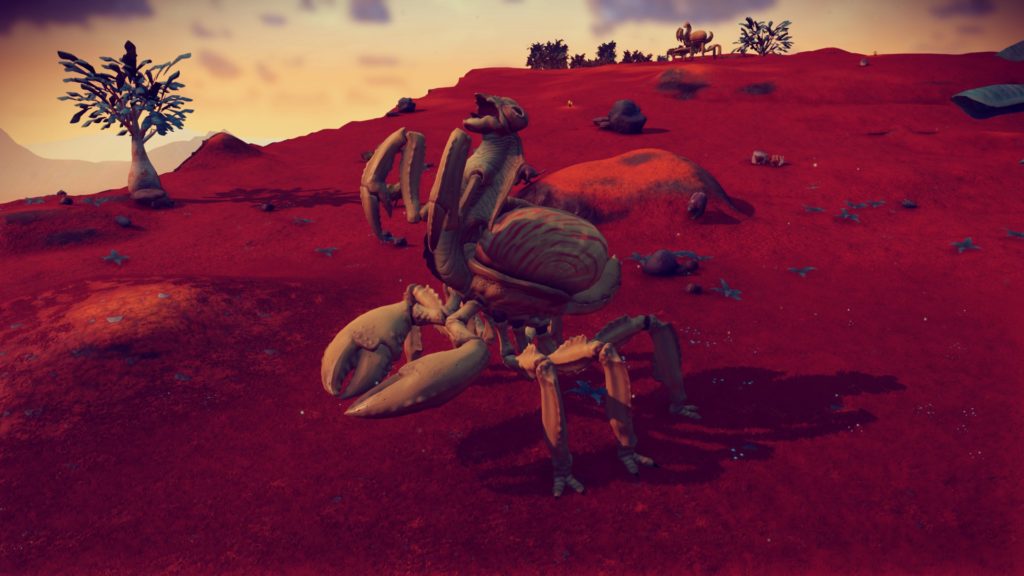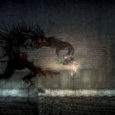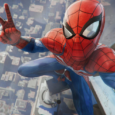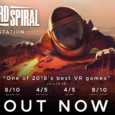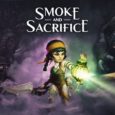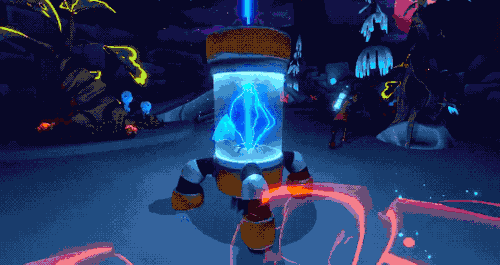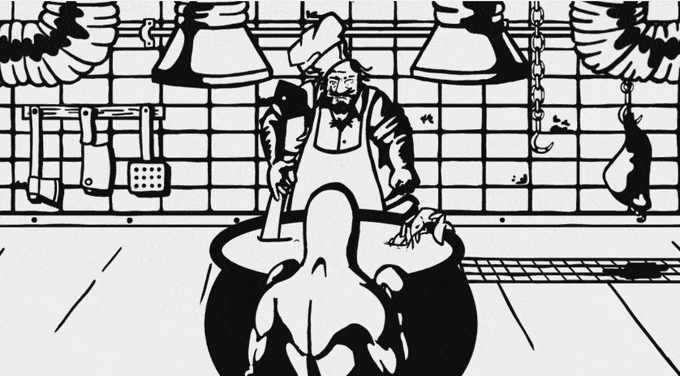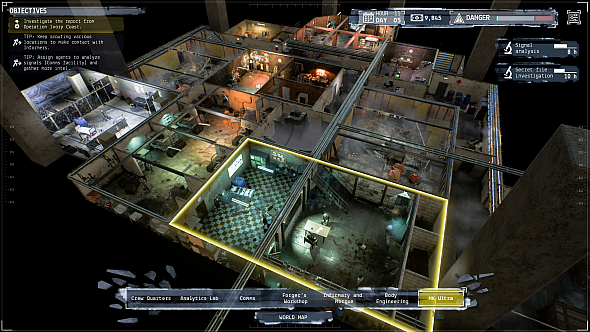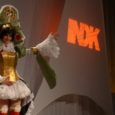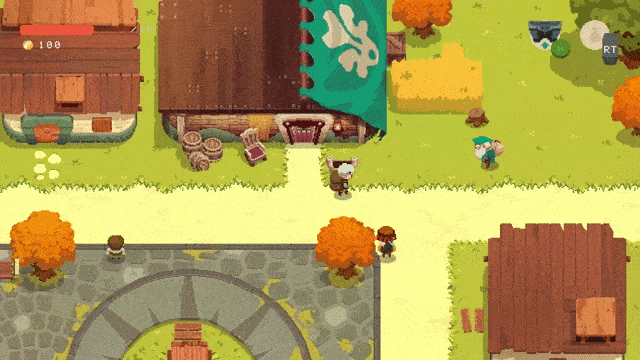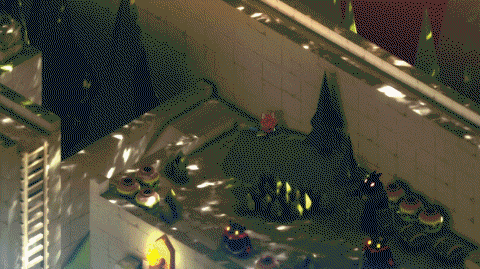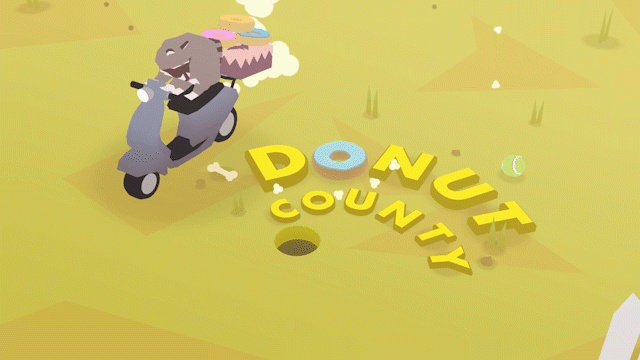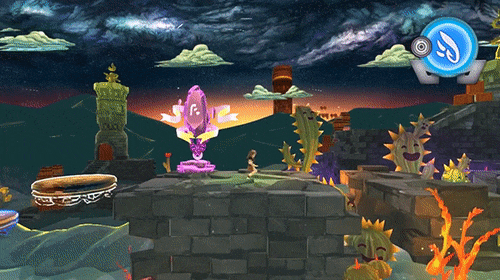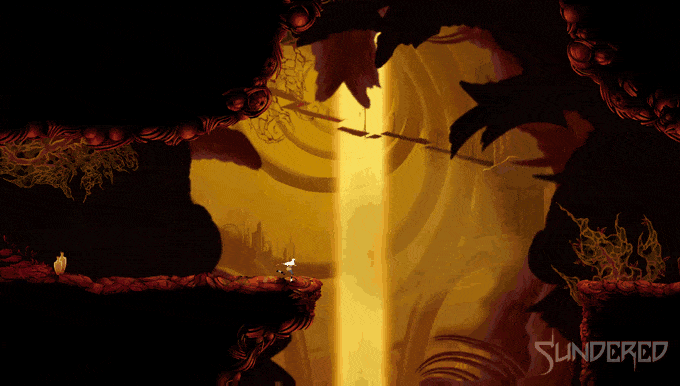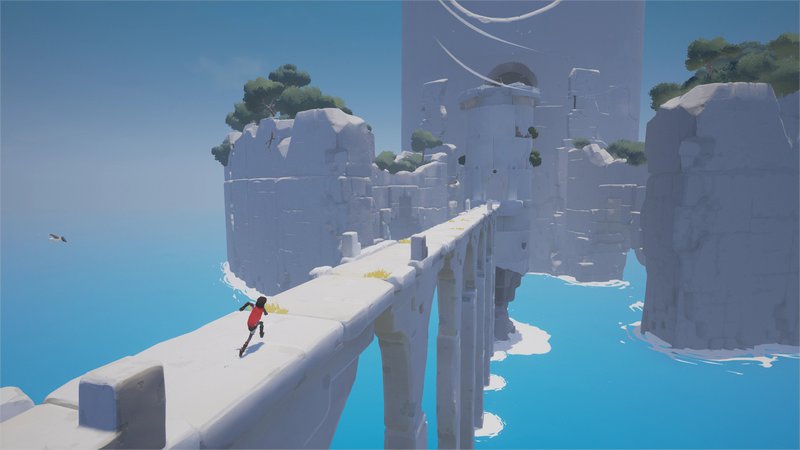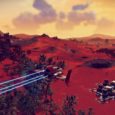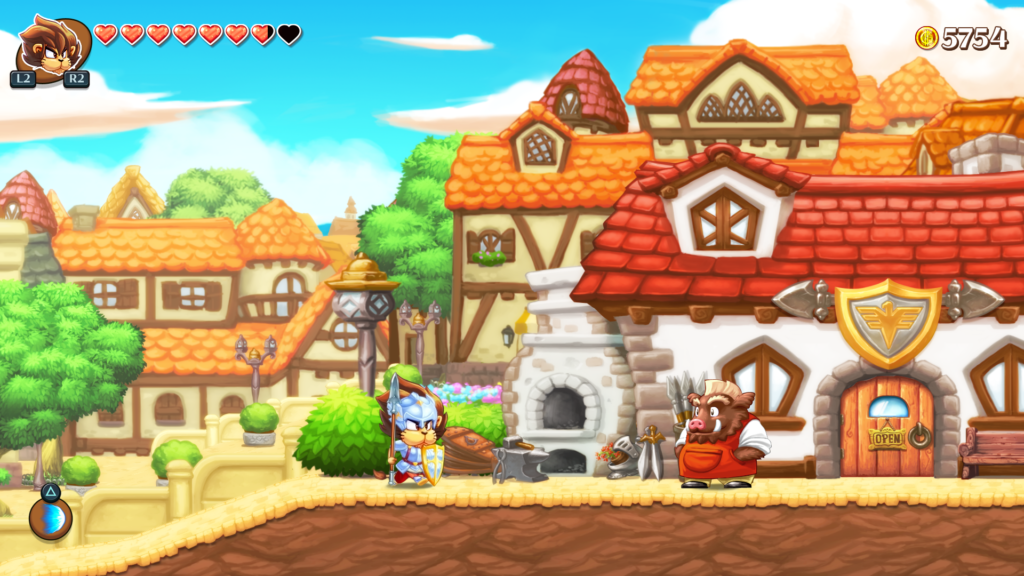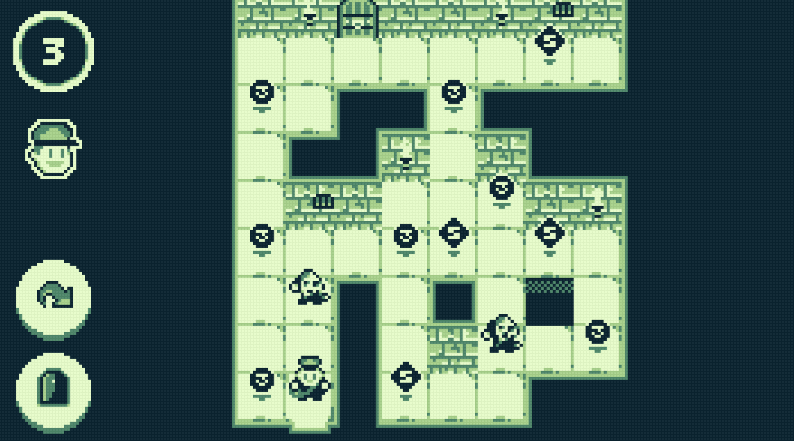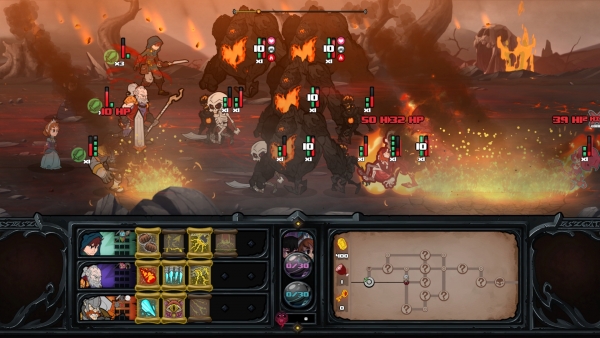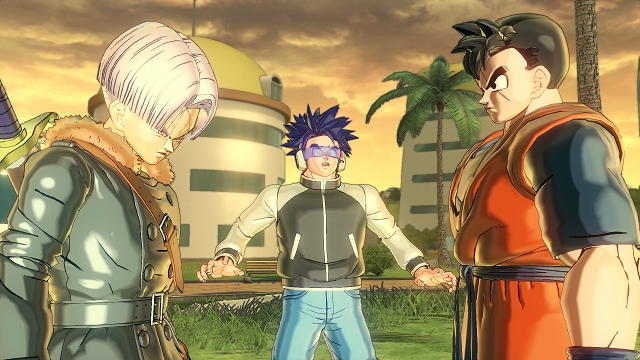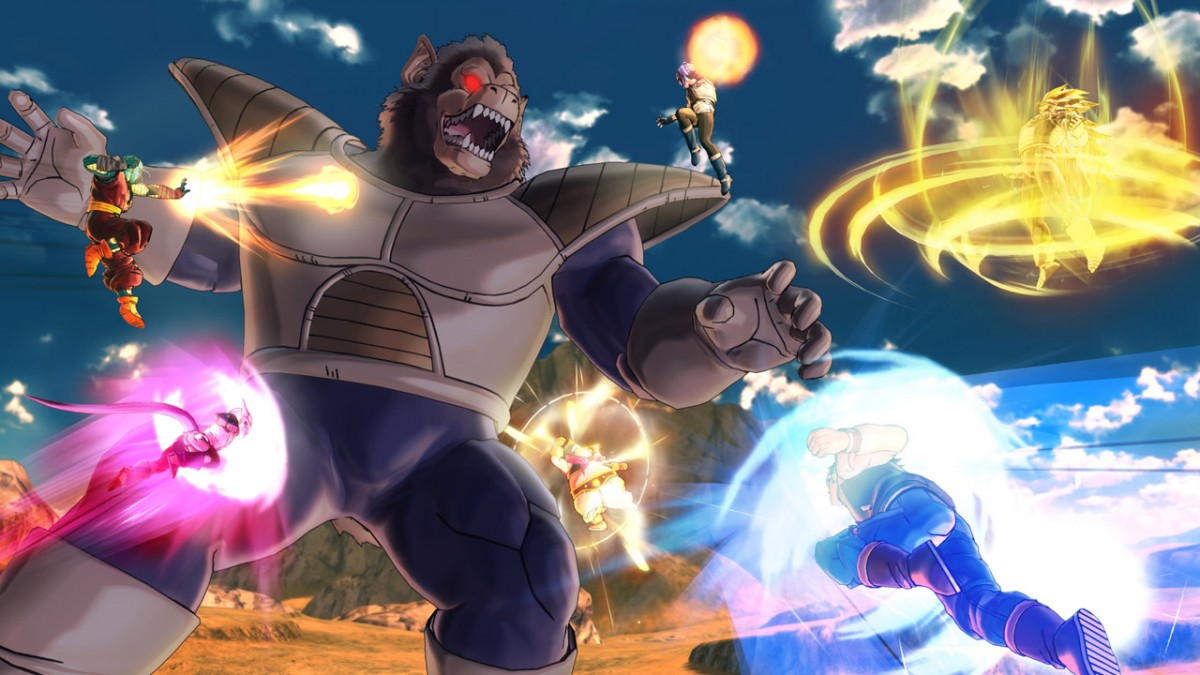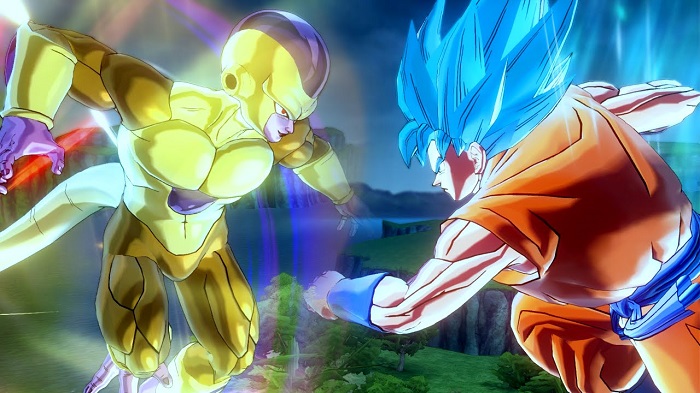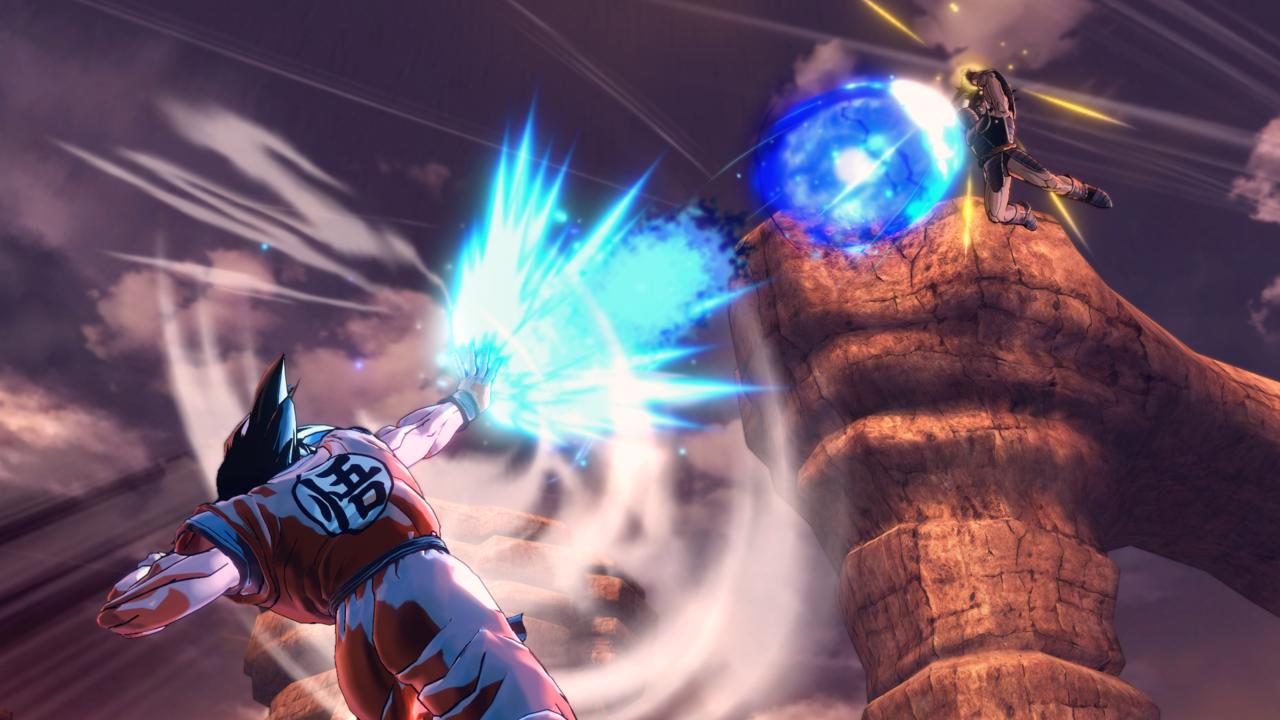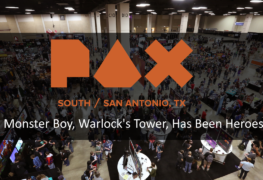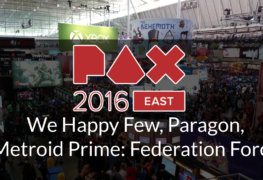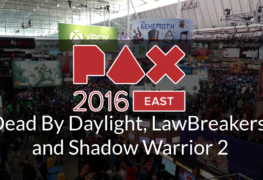It’s been a while since I’ve played No Man’s Sky and, to be fair, I thought I had completely written this game off entirely. When it first released in August of 2016, I fell deep into the hype trap, even shelling out the full $60 tag, something I am usually loath to do, and was subsequently burned. Once bitten, twice shy. After some more recent hype revolving around No Man’s Sky, though, this time with a $0 price tag since I’ve already bought into it, I decided to hop back in and check out what has really changed since launch. Find out what the ‘Next’ really means of the now titled ‘No Man’s Sky Next‘. Turns out, quite a bit has changed.
First of all, I find it weird that I’m using terminology and treating this game like it’s some sort of MMO, which now that there is some sort of real multiplayer going on I guess it is much closer to that. For all intents and purposes, though, No Man’s Sky Next still feels mostly single player. Which is fine by me. Usually, as a solo player, encountering other players in MMOs turns adversarial. We’re either fighting over the same drops, the same mobs, or fighting each other. That, as players, we’ve grown to consider this infighting ‘good, normal’ and ‘the way it should be’ is… odd. But I digress.
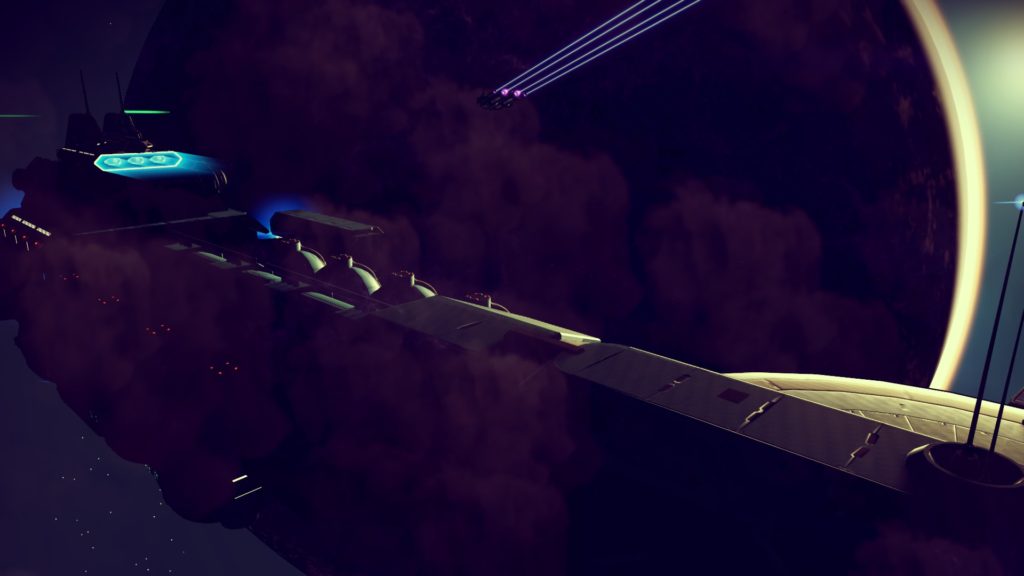
I delve back into No Man’s Sky Next after not touching it since release to see what has changed and if it’s worth playing again.
I remember when No Man’s Sky launched it felt like a wide ocean of content that was only a puddle deep. Everything was large and grand, but nothing felt important. There was no weight. Upgrades were acquired almost by accident and the primary focus was exploration… of similar, not-that-exciting locations. You could complete 99% of the game by just staying on the same planet you started on.
Now? Well, I’m not *entirely sold that No Man’s Sky Next is monumentally different, but it does feel a lot better. The focus has absolutely changed. Now, the focus is about building up your properties, your freighter fleet and your base, and completing the story missions. Your time spent on planets is transitory, hitting up only the points of interest you need to, and moving on. Which is good, because the less you see and pay attention to the procedural generation, the better. There was just not enough difference in the generation before. Now, it just feels… better. Planets feel more varied and look more populated. There’s more variety. I mean, there could always be even more variety in a game like this, but you don’t see the man-behind-the-curtain as much as you did two years ago.
Upgrades, too, seem to be made more from progress than from randomness, which is a much better feeling than just stumbling across the best weapon/ships in the game. That random big find is still included, too, though, but now instead of finding a big new ship, you now find a big *broken* ship that you need to spend a good chunk of time and resources fixing.
Again, it feels productive, not accidental. This is good.
Also, we need to talk about the screenshot capabilities. They are, hands down, the best screenshot options I have ever seen in any game. Period. And I consider myself a screenshot aficionado, so I don’t say this lightly.
At any time you can pause the game to take a screenshot. When you do, you can move the camera to any position around your character to take it, within a large distance. On top of that, if the lighting isn’t right, you can change the time of day and the position of the sun. You can add/remove clouds, change the depth of field, and even add an Instagram-like filter on top of all that. For real, all other games need to take a page from No Man’s Sky’s screenshot book. Screenshots are your players methods of advertising your game for you, and having a system like this only helps you.
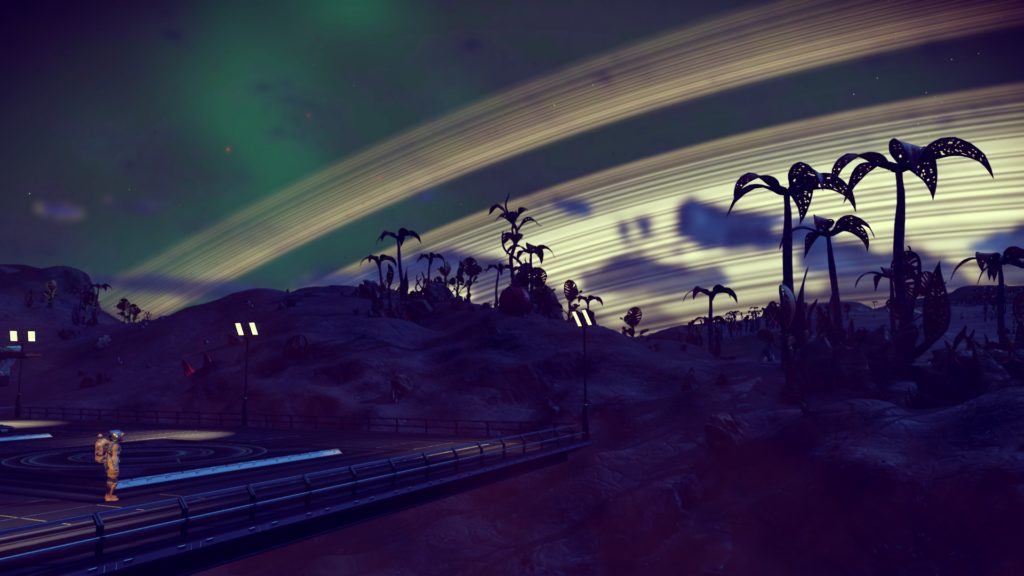
The Rings at Night! Glow Big and Bright! *clap clap clap clap* Deep In the Heart of… of… wherever this is.
So will I keep it up? No, of course not. I’m a rambling gamer and will pass quickly from game to game as my whim takes me. However, with No Man’s Sky Next focus having changed to one that feels purposeful instead of accidental, I’m a lot more apt to keep it going. Plus, the entire game fits into only a 10 GB footprint, which is efficient and impressive as anything.
It currently is still sitting at $60, though, which I wouldn’t say feels entirely worth it, but if it falls back down to $30, or even $40, I wouldn’t hesitate to suggest snapping it up. Have you hopped back into No Man’s Sky Next as well? Let us know on Twitter @SubCutured!
P.S. – If you’re looking for a good planet to settle down on, I highly suggest planet Ocho II in the Mucalls system. Red grass, bright sun, abundant resources, and a pleasant temperature all year long. Nice place to vacation. Just don’t murder me, okay?
Sub Cultured stopped by PAX South 2018 to check out all the delightful titles this convention had to offer!
Aftercharge
Aftercharge is a 3v3 asymmetrical FPS game. 3 players play as a group of robots trying to destroy a number of energy extractors on the map. They’re completely invisible unless they’ve just been damaged or are directly in front of an enemy. They have the ability to resurrect their allies and also a number of abilities to help them sneak around the map. The enemy team is invincible and has abilities to either impede the invisible enemies or buff themselves. The resulting combat are a stressful mix of sneaking/seeking and frantically trying to kill/run away before invisibility comes back. It’s a great deal of fun, especially playing with friends.
You can look for Aftercharge coming to Windows, Mac, and Linux in Spring of 2018.
Pato Box
Pato Box sees you take control of a duck boxer doing what he does best — box. Even in situation in which it may not be applicable like opening doors, this guy’s a punching machine. He was betrayed on his way to the top of his boxing career and is ready to punch his way to the truth. The art style is stark black and white, which is a visual treat and so much fun to watch. The combat responds as well as you’d expect of something that looks like a Sin City Punch Out. It’s a unique experience and definitely one worth checking out.
Pato Box will be out this Spring for PC, Mac, Switch, and PS Vita.
Phantom Doctrine
If Donut County was the simplest game at PAX South 2018, Phantom Doctrine is definitely the most complicated, and not in a bad way. If you’ve ever played XCom and wanted it to be deeper on basically every level, this is exactly the game you’ve been looking for. Set during the Cold War, you lead an organization called The Cabal dedicated to fighting global conspiracy. The game takes major events from history that are all true, but where most of the game occurs is in “what if this happened”-type scenarios. Like in XCom, there are missions to go on that you can play through, and a home base to manage. As the base, you can look through evidence you’ve collected to try and piece together your enemies’ plans, recruit new operatives, brainwash captives, acquire more funds, and take the heat off your agents. While in the field, you can choose to operate with stealth or being aggressive, gather intel or rush to the objective. The game is really flexible to how you want to play it and how you want to spend your time. If you want to spend 20 hours in the base making sure everything’s perfect for the next mission, you can. If you want to speed run through the missions, you totally can. Missions also allow you to have special abilities like spotters, snipers, and grenade launchers, which come in handy when in a sticky situation.
If you’re ready to sink your teeth in to the deepest tactical game in quite some time, get hype for Phantom Doctrine coming in 2018 to at least PC.
Check out more of our coverage from PAX South 2018!
Party Hard 2, Due Process, The Swords of Ditto
Moonlighter, Tunic, Donut County
Sub Cultured stopped by PAX South 2018 to check out all the delightful titles this convention had to offer!
Moonlighter
Moonlighter is like if Recettear and a Roguelike had a baby. You play as a shopkeeper outside of an ever-changing dungeon. Your task is to sell goods to people. When you do, you earn money so you can get better equipment and craft better items to either sell or use yourself to go in to the dungeon. Clearing the dungeon will yield new items, which you can craft and sell in your shop, et cetera. It’s a big ol’ capitalism loop. The dungeon is different every time you enter, which makes it that much more fun. There’s 5 different entrances to the dungeon and characters to interact with so there’s presumably an end, but with the varying dungeons, bevy of characters to please, and loot to grab, you may not ever want to see it.
Moonlighter will be coming out in 2018 for Xbox One, PS4, PC, Switch, and Mac/Linux.
Tunic
Tunic has so much style that it hurts. Zelda is the easiest comparison — you’re a lone adventurer (in this case a lil’ fox) in a mysterious world who collects items that open up new paths. If Hat In Time is a cute-as-heck platformer, this is a cute-as-heck action/adventure game. The controls are tight and responsive and the combat feels fluid and satisfying. An extra layer of polish/intrigue to this game is the concept that it’s a game you’re just discovering that was made in a foreign country, so you’ll see parts of the manual in the game and all the text is in a made up language you don’t understand. Even the website has this language peppered about.
This game is one of the ones we were most excited by at PAX South, so be on the lookout for it coming out later this year to PC, Mac, Linux, and consoles in 2018.
Donut County
Once upon a time, @PeterMolydeux had a joke game description in which you play as a hole in the ground. From that, Ben Esposito created one of the most simple, but compelling games at PAX South, Donut County. The mechanics are simple — you play as a hole in the ground swallowing things up. The more you eat, the bigger your hole gets, which allows you to eat bigger things. Think reverse Katamari. Between levels, you’ll also get a glimpse into the lives of the citizens of Donut County which has been upended by this dumb hole. The art style is simple and effective, the humor isn’t overdone, and the gameplay, though simple, is satisfying.
Donut County is coming to PC, Mac, and iOS in 2018
Check out more of our coverage from PAX South 2018!
Aftercharge, Pato Box, Phantom Doctrine
Party Hard 2, Due Process, The Swords of Ditto
Prisma & The Masquerade Menace
Prisma & The Masquerade Menace is in the early stages of development, so early in fact that it’s not even on Kickstarter yet. That didn’t stop the developer from having a fully playable level from the demo at PAX South.
It’s got some rough edges, but it’s already rather polished. At its core, it’s a platformer game in which you take control of Ray, a girl who can switch between different colored dimensions to make objects appear or disappear. Each of these dimensions also gives her abilities like high jumping, fast running, and block destroying. Once you get used to switching between dimensions, it becomes much more like a Sonic game in which you feel compelled to go as fast as possible, switching dimensions quickly and trying to think on your feet.
Prisma is still in its early stages, but give their Kickstarter a look when it goes live later this month!
Sundered
Sundered is a game that leaps out at you from a sea of titles at a gaming convention. It’s art style has a way of pulling you in, making you want more.
Sundered is a Metroidvania style platformer/exploration game in which you take control of Eshe, a wanderer exploring seemingly endless, always changing caverns filled with eldritch horrors. The controls solid and responsive and the game’s difficulty is a little more than Super Metroid (we died 3 times in the demo), making it feel like a substantial single player experience. Details like the hand drawn art and pencil marks when the camera is really zoomed in all combine to make this a visual feast that also delivers on a tight experience.
Sundered is coming out to PS4 and PC in July but you can Kickstart it right now here!
RiME
In RiME, you play a boy exploring a strange island trying to work your way to a pillar in its center. Along the way, you’ll solve puzzles, meet a super cute fox, and try to figure out the mysteries of your surroundings and what could have happened to make it the way it is now.
RiME feels a lot like Zelda mixed with Journey in the best possible way. The art style is stark and gorgeous, varying dramatically for different areas in the game. The world is all laid out in a way that’s easy to understand visually, which is a good thing since the game features no dialog or text, so you’re relying on just trying things out and being observant to solve puzzles.
RiME is due out summer 2017 on PS4, Xbox One, PC, and Nintendo Switch.
Want more PAX South 2017 coverage? All you had to do was ask!
Monster Boy, Warlock’s Tower, and Has Been Heroes
Minit, Beat Cop, and Strikers Edge
Arms, Splatoon 2, and Legend of Zelda: Breath of the Wild
Monster Boy
Monster Boy started as a Kickstarter project called “Flying Hamster.” Since then, the team welcomed Ryuichi Nishizawa and turned the game into Monster Boy, based off the Wonder Boy in Monster World, a mashup between the Wonder Boy and Monster World series. Please go look those up if you have no idea what we’re talking about.
The player takes control of Jin, a boy who can transform into five different monsters to solve puzzles and take down enemies with a variety of abilities. This platformer hearkens back to old school platformers in the 80s and 90s — simple gameplay, peppy music, bright visuals. Like a Saturday morning cartoon video game that you set your alarm for.
Monster Boy is simultaneously releasing on Nintendo Switch, PS4, and Xbox One later this year.
https://www.youtube.com/watch?v=wQ6DYSf5VNE
Warlock’s Tower
Some game developers try to emulate the style of classic pixel games and achieve something between nostalgia and amusement. Then you have a game like Warlock’s Tower, which just looks like it’s always been a Gameboy game and dares you to tell it otherwise.
The graphics of Warlock’s Tower look exactly like an original Gameboy game being played on the Super Gameboy player, complete with being able to change main color from green to orange yellow. All of that helps Warlock’s Tower in the charming area, but the underlying gameplay is really cool, too.
At it’s core, Warlock’s Tower is a puzzle game in which you take control of a mailman trying to avoid monsters and deliver a letter to the warlock of the titular tower. Each move you make takes away one life, but there are tokens on each floor to increase the number of lives you have. It’s a puzzle to be able to figure out which tokens to get at what time and using what directions. The game even has Twitch integration so you can interact with your chat while you play.
Warlock’s Tower is out now for PC.
Has Been Heroes
Has Been Heroes is a Roguelike inspired by Plants Vs. Zombies.
Oh, what, you need more?
In the game, you’ll take control of three characters, each with their own lane. Each character has a different number of attacks, attack power, and control of spells. It’s up to the player to time their attacks accurately, swap characters, and utilize spells cleverly to fight back hoards of enemies.
At first, it takes a bit to get used with character switching and the concept of enemies having points with which to block your attacks, but very quickly, you’re pausing the game less, attacking with one character, swapping another in after the shield is broken to follow up with a health attack, and using spells on the fly. It’s satisfying to feel in control, but also like your heart is in your throat trying to figure out if your abilities will be off cooldown before the next enemy reaches you.
Has Been Heroes comes out March 28th for Nintendo Switch, PS4, Xbox One, and PC.
Want more PAX South 2017 coverage? All you had to do was ask!
Prisma and The Masquerade Menace, Sundered, and RiME
Minit, Beat Cop, and Strikers Edge
Arms, Splatoon 2, and Legend of Zelda: Breath of the Wild
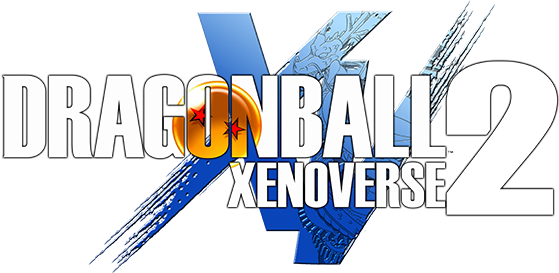 Dragon Ball Z games have launched in various degrees of quality. It is always good to practice skepticism with these games because for every great game like Dragon Ball Z Hyper Dimensions on the Super Nintendo, we get three horrific entries like Dragon Ball Z Raging Blast. It is never fun being burned by a bad game adopted from a pre-existing franchise with personal and nostalgic ties. Thankfully the new Xenoverse series has acted as a new age for incredibly fun Dragon ball Z games when the first entry came out back in 2015. The sequel, Dragon Ball Xenoverse 2, moves the franchise forward with minimal changes but carries the torch of the original by bringing quality, fandom, kinetic controls, and an incredible roster to longtime fans of the anime.
Dragon Ball Z games have launched in various degrees of quality. It is always good to practice skepticism with these games because for every great game like Dragon Ball Z Hyper Dimensions on the Super Nintendo, we get three horrific entries like Dragon Ball Z Raging Blast. It is never fun being burned by a bad game adopted from a pre-existing franchise with personal and nostalgic ties. Thankfully the new Xenoverse series has acted as a new age for incredibly fun Dragon ball Z games when the first entry came out back in 2015. The sequel, Dragon Ball Xenoverse 2, moves the franchise forward with minimal changes but carries the torch of the original by bringing quality, fandom, kinetic controls, and an incredible roster to longtime fans of the anime.
The adventure continues to be yours in this entry and you again create your own character to participate in some of the most memorable fights in the Dragon Ball Z lore. Expect all the fast action, hard punches, enormous energy beams, and evasive teleportation maneuvers that made the TV show iconic.
There are plenty of customization options to choose from as you appoint you look to the five races of, Sayian, Namekian, Human, Buu, and Frieza race. Each race has their own ability to transform. Sayians go Super, Frieza goes perfect, Buu goes Kid, humans have hidden potential, and the Namekian’s grow large like Lord Slug. Nobody is left out of the transformation game this time around which levels the playing field in a big way. The other races lacked a true transformation which found those character under powered when fighting against transformed Super Sayians. This addition was more than welcomed.
Once you cook up your fantasy character, you are dropped right into the world of the Time Patrollers where you’ll help keep time’s flow safe from the dastardly villain duo of Towa and Mira. These characters return from the first game and use their energies to increase the power of other villains across time. These time manipulators team up with Turles and Lord Slug and tackle every major moments in the Dragon Ball Z history. These super powered versions of classic villains are determined to change the timeline for the worse. Your job as a Time Patroller is to ensure that the events go according to how they originally transpired. For whatever reason your original character’s presence does not affect time like the presence of new villains, so in that aspect the narrative makes little to no sense. Leave logic at the door for this story folks. The time traveling rules are basically nonexistent and offered up in convenient and illogical ways.
The mechanics are not much different from Xenoverse 1, however, they are refined and honed. Everything just feels faster in all the right ways, which for a Dragon Ball Z game is majorly important. You want to feel like Vegeta when reeling back for a final flash and you want to harness the speed of Gohan when you are zipping around the large areas looking for the next bout. This game delivers on that fantasy of embodying a Z Fighter, and any fan of the series would be hard pressed to feel differently.
There are plenty of customization options as you progress in the game. Once you start collecting costume pieces and buying new articles of clothing with your awarded currency. You can look like some of your favorite characters or go for a completely unique look as you pan through your item drops to see which clothing has the best stats and look. If you don’t like the stats but love the look of your clothes, there is a remedy for that! QQ Bangs can be mixed up by combining clothing and power items. This negates the effects of the clothing stats which, in turn, uses the QQ Bang stats, which gives you the choice to look how you want but have the stats that fit your play style.
There are other things to do in the HUB world as well. This world acts as your lobby, a place your character engages in as you queue up missions and quests.This open area known as Conton City, is much bigger than Xenoverse 1’s HUB world of Toki Toki City. Your created characters. It is so awesome to see all their creations as you run around the world communicating through emotes. Bonus: No load times for this HUB area with up to 250 other player-controlled combatants, all with their owns hinder this areas as you fly from end to end and do small quests and missions in that world.
There are plenty of activities to occupy your time in Conton City. Time rifts are quests that has you going to famous locations like Guru’s house, Frieza’s ship, Capsule Corp Building, and Master Roshi’s Island. Here you will find your character participating in missions that are specific to these locations. Guru’s house will have you fighting off Frieza forces and collecting Namekian Dragon Balls. While over at Frieza’s ship you will find yourself aligning with different Lieutenants as they usurp one another all in the name of becoming Frieza’s right had man. Dragon Ball Xenoverse 2 does not lack content, but it does lack diversity. In any of these quests, the main thing you are doing at any time will always be fighting. The only things that do change are the enemies, the win and lose stipulations, and the arenas you fight in. It sounds like a negative point but it is no more repetitive than any other fighting game.
The gamplay loop is very exposed early on, but that comes with the territory of these mission based/grind heavy/loot collecting games. You will spend your time doing all the various types of missions I have talk about, which are ultimately the same mechanically. You will load up a story mission, fight some bad guys, and then at the end of the match get some credits, items drops and possibly even new moves. You will then utilize item drops, sell them off, or mix them into new items. Doing story missions unlocks patrol missions which are just variations of the story quests. In between these mission you can do all the time rift events which, again, is just more fighting. The game is repetitive, there is no denying that. I think this shortcoming is overshadows by all the other working parts of this game though.
The story and mission progression have not changed much from Xenoverse 1. The story itself is all about fixing the timeline of the original series, while the Patroller Missions, which can be played up to 3 players co-op online, takes more creative chances as yr avatar teaming up with the bad guys in alternative-history-like scenarios. Playing online with 2 other friends is a blast and has quickly become one of my favorite co-op experiences of this year. There are also 6-player raid missions where you’ll participate in fighting big bosses for big payouts and loot. These fights get incredibly large scale in terms of the open spaces you occupy and the amount of movement and activity going on at any given time. The intensity levels of these battles really ramp up as the screen becomes a cornucopia of colors as you blast energy waves together in an attempt to take down the damage sponges in the form of long time villains.
Out of all the games this year that I have played, the only game me and my gamer group could agree on to play co-op this year was Dragon Ball Xenoverse 2. My squad and I loved the first game and played hundreds of hours of co-op, so it was obvious that we would return to this series. Also an important personal note if you’re debating to purchase this for group gaming: out of the four people I play this game with, only 2 of us are major Dragon Ball Z fans, one is a passive fan, and the other hates the entire series. He plays the game because it offers fun co-op, jaw dropping graphics, and a great fighting game/action RPG hybrid.
There is nothing else like the Dragon Ball Xenoverse series. The creative team, Dimps, has taken everything they did right about earlier fighting game entries, and shaped it up into an Action/Adventure RPG hybrid. Much like what Gearbox did with marrying the first person shooter genre to the Role Playing Game genre with Borderlands, Xenoverse series successfully merges two completely different game types to make something that feels fresh. I think that anybody, fan or not, that is willing to give it a try, can find something to enjoy about this game. Buy it now if you’re a longtime fan, try and check it out if you have a passing interest…but this is one of those gems of this year that will be sorely under-appreciated by most of the gaming community.


